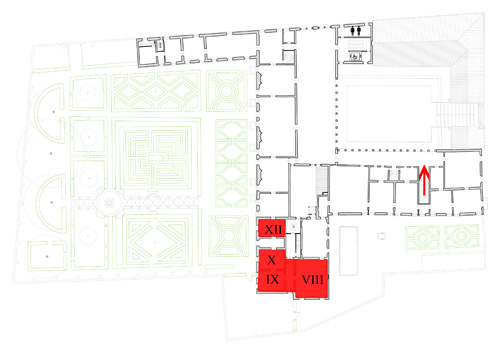
Room VIII
Spina survives the violent end of the Etruscan- Padan centres because of its connotation as a merchant city, a strategically crucial marine outlet even for the Celtic populations lacking in marine skills. There are clear signs, especially in the second half of the fourth century BC, that document new trade routes and new areas of interest. An analysis of the grave goods dating from the second half of the fourth century BC shows, on the one hand, a decline of objects in terms of quantity, on the other, a drastic reduction in imports from Attica with the emergence of alternative manufactures. Comparatively few are high-ranking tombs where the rare Attic vases,often older than the other objects, become symbolic family goods.
The tomb 4C of Valle Pega reflects these changes: there is still painted Attic pottery, although with the latest products of this type, while the Etruscan pottery produced in Volterra appears. The new workshops, which produce small vases, suitable for land transport on carts, connect to Spina through the Tuscan-Emilian Apennines, probably controlled by the Celts with which the Etruscans were able to set up a friendly relationship.
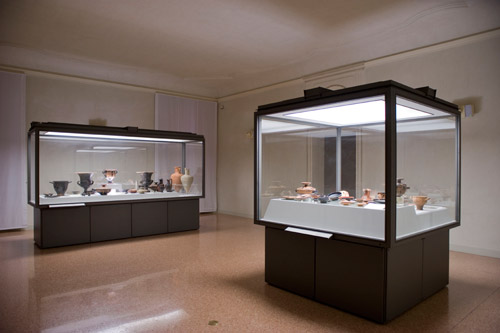
In the second half of the fourth century BC, Sicily and Magna Grecia, the centre of the ceramic production called "Gnathia" , became new major trading partners of Spina. Through this new trade route luxury products also reach Spina, such as a pond patera produced in southern Italy with the apotheosis of Heracles and a banquet of the gods on Olympus, and a phiale (cup) in glass paste, an imitation of metal prototypes, of oriental origin (Asia Minor). The Sicilians red-figure pottery production is well represented by the lekane and the pyxis of the tomb 2B of Valle Pega, also of a woman.
The findings of the tomb 1188 of Valle Trebba, dated between 325 and 300 BC, are attributed to a tomb of a Punic adolescent, deposited with a death mask for apotropaic purposes. Many among the findings of this period - found in more than 300 graves of the more than 4,000 total - are the commercial amphoras, particularly for wine, that symbolically represent the wine offering brought by the deceased for the afterlife symposium.
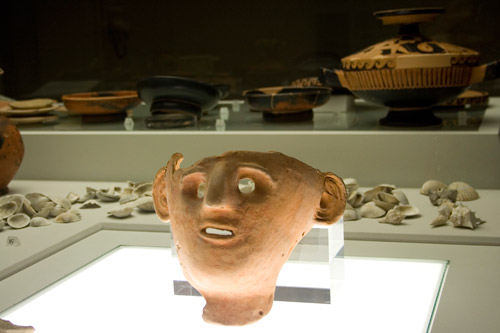
Room IX
Ceramics from Etruria (Volterra and Chiusi), and from Magna Graecia and Sicily, as well as local workshops, about 325 BC replaced Attic pottery in the graves. Cooking waste found in Spina testify, perhaps as a result of the movement of artisans, the presence of the workshops of potters who, along with productions in gray and purified clay, tested themselves by painting vases in black and overpainted in red.
The most interesting phenomenon of the time is the so-called "Upper-Adriatic pottery" that were found in several centres on the Adriatic coast of the Marche and Adria. Spina seems to have been a production centre as well as an important centre for distribution along the coast, on the other side of the Adriatic (Istria) and inland as far as Bologna. Derived as for the forms and decorations from the latest expressions of the Attic pottery, High Adriatic ceramics are represented mainly by banqueting items (craters, jugs and cups), initially decorated in red-figure technique, often with female heads in profile, with hair enclosed in an embroidered cap (sakkos), using black strokes on a white background with purely ornamental plant motifs.
.
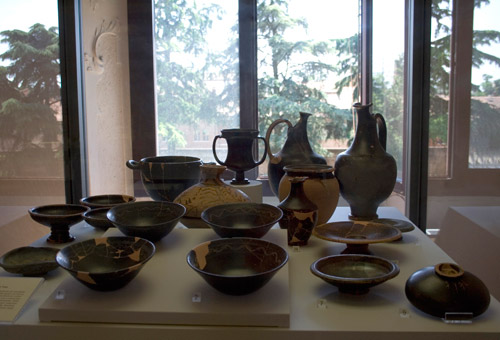
To accompany the dead in burial were both figured vases and those with overpainted colour produced by the flourishing workshops of Puglia (trefoil oenochoai with long neck from the tomb 505C) and Upper Adriatic pottery (skyphoi Tomb 38C). Votive statues and busts in terracotta, found both in tombs and in the town, are also influenced by the world of Magna Graecia. Specific objects from the feminine world are a wooden box for cosmetics and an alabaster perfume container from the tomb 38C.
This is the period when, according to some scholars, to avoid the coastline gradual shift to the east , the inhabitants of Spina, deprived of their fertile hinterland and attracted by the proceeds of piracy, dig a canal to connect the city to the open sea.
Room X
The general "tone" of the city between the end of the fourth century BC and the beginning of the third is much different to the splendor of the previous century: the town has strongly withdrawn to itself in a prelude to the event of '"evacuation" of its inhabitants, as mentioned by the Greek historian Dionysius of Halicarnassus in the first century BC. In the grip of Celtic tribes and cut off from the rich hinterland, once reclaimed and cultivated, which had in the city of Felsina (Bologna) as it’s soul economic and political strength, Spina heads towards a rapid decline .
Nevertheless, a vital relationship with its own Etruria still remains vital, as confirmed by an antique source that memorizes a three day journey from Spina to Pisa.
Ceramics from Volterra and Chiusi are a true reflection of this link. From Volterra, the factory called "Malacena" - the name of the place where they were identified for the first time, originate the fine black-painted pottery and a characteristic type of ceramic overpainted with swans and palms, while Chiusi produces rarer figurative ceramics.
The findings of tombs 646C and 654C of Valle Pega, demonstrate the most common forms of Etruscan red-figure production, such as the skyphos and the column krater. Of particular interest is the black painted ceramic service from the tomb 646C consisting of a large plate with graffiti in the name of the deceased Perknas and a series of bowls of various sizes bearing only the initial.
Room XII
Two objects of great value, placed next to a few simple objects, are the symbols of the rank of a woman buried in the last two decades of the fourth century BC.
A precious amber necklace with double-headed pendant, a personal ornaments of the deceased, and a gilded kantharos with the head of Heracles and a girl with a helmet (Athena, Amazon or Onfale ), a refined product of a specialized workshop in Chiusi (Clusium Group) occupy a prominent place in the tomb 1029B of Valle Pega, which includes commonly used pottery in this particular historical moment, such as black or gray painted containers of Etruscan and Upper Adriatic production.
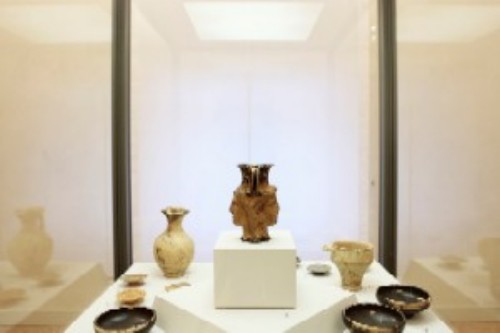
Next room